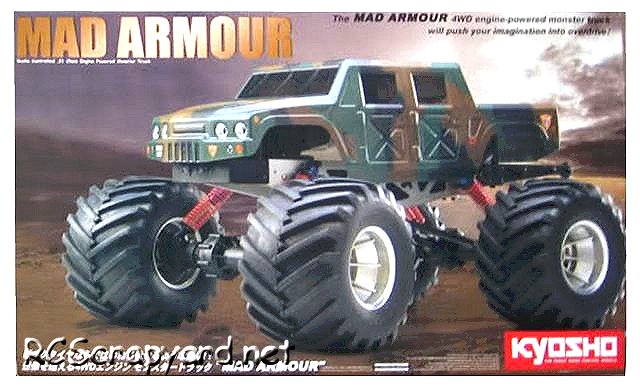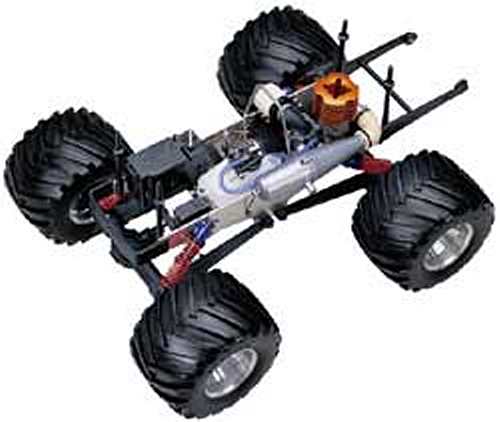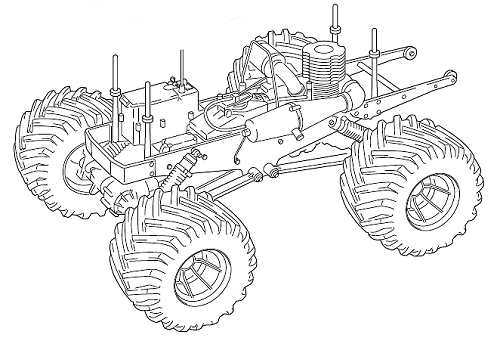

|
|
|


|
|
1/8 Scale Nitro Monster Truck:
Kyosho Mad Armour - 31224
|
Released by Kyosho in 2002, the 4WD Mad Armour Monster Truck - # 31224 - is shaft driven, with a vertical plate, ladder-frame chassis, gear type differentials, coil spring over oil filled dampers, dogbone drive-shafts and prop-shafts, 3-speed transmission, a full set of ball bearings and a GS-21R engine with recoil starter.
Check out our Kyosho Archive for other Vintage Monster Trucks models.

To race the Kyosho Mad Armour, it needs to be tuned to perfection for better stability, precise steering and provide enough grip to keep you on the track when going around tight bends at high speed. Even the smallest adjustment can change the feel of a car and our simple to follow instructions will guide you to the best Set-up to get you to the front and keep you there.








|
|
|

★ Kyosho Mad Armour Chassis ★

★ Kyosho Mad Armour Chassis ★

|
Buying a Used Kyosho Mad Armour
|
|
Manufacturers and Brands Catalogued, Listed and Reviewed by RC-Scrapyard.
At present, the RC Model Manufacturers, Brands and Distributors covered by us are: ABC Hobby, Academy, Acme Racing, Agama Racing, Amewi, Ansmann Racing, ARRMA, Team Associated, Atomic RC, Axial, AYK, Bolink, BSD Racing, Capricorn, Carisma, Carson, Caster Racing, Cen, Corally, Custom Works, Durango, Duratrax, ECX - Electrix, Exceed RC, FG Modellsport, FS-Racing, FTX, Fujimi, Gmade, GS-Racing, Harm, HBX, Helion, Heng Long, Himoto Racing, Hirobo, Hitari, Hobao, Hong-Nor, Hot Bodies, HPI, HSP, Intech, Integy, Jamara, JQ Products, Kawada, Kyosho, Losi, LRP, Maisto, Mardave, Marui, Maverick, MCD Racing, Megatech, Mugen, New Bright, Nichimo, Nikko, Nkok, Ofna, Pro-Pulse, Protech, PTI, RC4WD, Redcat Racing, RJ-Speed, Robitronic, Schumacher, Seben, Serpent, Smartech, Sportwerks, Step-Up, Tamiya, Team-C Racing, Team Magic, Thunder Tiger, Tomy, Top Racing, Traxxas, Trinity, Tyco, Vaterra RC, Venom, VRX Racing, WLToys, X-Factory, Xmods, Xpress, Xray, XTM, Yankee RC, Yokomo, ZD Racing and Zipzaps. |
|
Hints, Tips and Information
Radio Frequencies - be Careful be Safe
After buying your first car, it won't be long before you need more than simply bashing around the back yard, or out on the street. So you will be looking around to find a club that is not too far away where you can do some serious racing. |
|
Hints, Tips and Information
Look after your Gears
In RC there are a number of different gear teeth sizes we tend to use, based on two systems. Imperial and metric. |
|
RC Models:
|
Radio & Motors: |
Other
Accessories: |